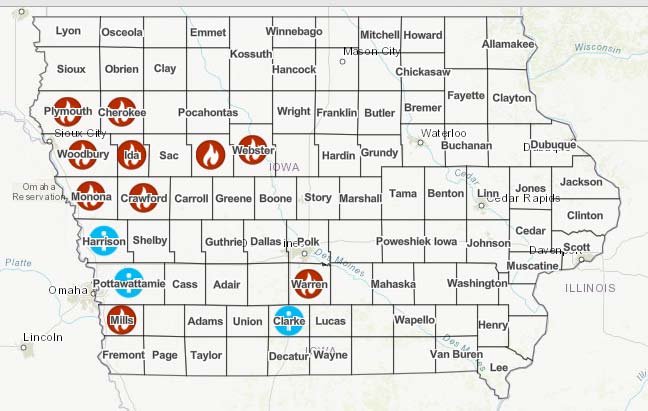CLICK HERE for the latest market quotes from the Iowa Agribusiness Network!
CLICK HERE for the latest market quotes from the Brownfield Ag News Network!
CLICK HERE for the latest market quotes from the Iowa Agribusiness Network!
CLICK HERE for the latest market quotes from the Brownfield Ag News Network!
DES MOINES, Iowa (March 18, 2022) – The Iowa Department of Agriculture and Land Stewardship (IDALS) and the United States Department of Agriculture (USDA) Animal and Plant Health Inspection Service (APHIS) have confirmed a second positive case of highly pathogenic avian influenza (HPAI) in Buena Vista County, Iowa. The virus was found in a flock of commercial layer chickens. This is the second confirmed case of HPAI in Buena Vista County, Iowa. The first case was in a commercial turkey flock on March 6.
Flock owners should prevent contact between their birds and wild birds and report sick birds or unusual deaths to state/federal officials. Biosecurity resources and best practices are available at iowaagriculture.gov/biosecurity. If producers suspect signs of HPAI in their flocks, they should contact their veterinarian immediately. Possible cases should also be reported to the Iowa Department of Agriculture and Land Stewardship at (515) 281-5305.
According to the U.S. Centers for Disease Control and Prevention, the recent HPAI detections in birds do not present an immediate public health concern. No human cases of these avian influenza viruses have been detected in the United States. It remains safe to eat poultry products. As a reminder, the proper handling and cooking of poultry and eggs to an internal temperature of 165 ˚F kills bacteria and viruses.
(Harlan, Iowa) – Recent snow and rain events have allowed the Burn Ban to be lifted in Shelby County, effective immediately. That’s according to Shelby County Emergency Management Coordinator Alex Londo. The ban was put in place Feb. 11th, following numerous field and grassland fires that began either accidentally or as part of a controlled burn that went out of control.
Burn bans are issued by the Iowa Fire Marshal, after consultations with local officials, including EMA and Fire Chiefs. Burn bans were also recently lifted in Harrison and Pottawattamie County. In southwest Iowa, only Mills County had an active burn ban in-place, as of 3-p.m., Friday (today).
(March 18, 2022) – Iowans interested in issues vital to rural communities are invited to attend the 2022 Iowa Rural Summit, organized by the Iowa Rural Development Council. The event will be held on April 12th and 13th at the Gateway Hotel and Convention Center in Ames, Iowa. Communities are encouraged to register teams of three, though individuals are also eligible to attend the event. New for the 2022 Summit, college students interested in rural issues and economic development can register at a reduced price.
To register for the event as an individual, a team, or a student, visit www.iowardc.org/summit. The cost for a three-person team is $210. Individuals can register for $190 and students for $25. The registration fee includes admission to all Rural Summit events, breakfast on Tuesday and Wednesday morning, and lunch on Tuesday. Bill Menner, Iowa Rural Development Council executive director, says “We’re looking forward to a great Summit this year in Ames. Last year’s Summit brought together nearly 250 Iowans, and we hope Ames’ central location will encourage more to attend this year.” 
The Iowa Rural Development Council was formed in 1992 as part of a Presidential Executive Order. Today a broad range of public-private partners supports its focus on empowering small towns and building capacity for rural leaders. Sponsors for this year’s summit include the Iowa Farm Bureau’s Renew Rural Iowa initiative, ITC Midwest, Iowa’s Small Business Development Centers, D.A. Davidson, the IADG Community Foundation, Impact 7G, Grinnell Mutual, AARP, Iowa’s Cultivation Corridor and Monkeythis.
(Radio Iowa) – Beekeepers are starting to get ready for the bee season as temperatures warm up — but the twin impacts of inflation and supply shortages are causing concerns. H.R. Cook picked up beekeeping as a hobby when the COVID-19 pandemic started two years ago. Now he also finds himself having to pay more for the materials he needs for beekeeping, which includes lumber, with prices that are up to three to four times what they have been for the past ten years. He tells K-C-R-G T-V some supplies have been hard to get — like those plastic bear containers for honey.
”Which are made in China, they have to be shipped from China,” he says, “there are millions of these honey bears sitting over on a cargo ship, to glass jars that we put the honey in and we sell at the farmers markets.” Phylicia Chandler is a beekeeper and member of the Dubuque Swiss Valley Bee Club. She told K-C-R-G T-V she knows of other beekeepers who have struggled to find hive equipment and honey extractors — which could be very detrimental to beekeepers.
”When we need something, we need it now,” she says. “And it can be a matter of if you are catching a swarm and you do not have what you need, then you have nowhere to put those bees if you do not have that extra hive,” Chandler says the good side of the issue is she has noticed how so many beekeepers in eastern Iowa have come together to support one another.
”Beekeepers work together, so if they are ever in need we call on other beekeepers to help us out,” she added. Cook says people who make a living out of beekeeping are probably feeling the impact the most. He says commercial beekeepers usually ship their bees to California during the winter to pollinate almond trees and now bringing them back with high gas prices and inflation is proving to be quite the challenge.
(Radio Iowa) – What’s known as “The Gathering of the Green” gets underway today (Wednesday) in Davenport, but it has nothing to do with Saint Patrick’s Day. This event bills itself as the world’s largest gathering of John Deere enthusiasts — in the Quad Cities, where Deere is headquartered. Event chairman Tony Knobbe (kah-NO-bee) says one big attraction is the workshop on farm tractor restoration. “If you are buying or are going to buy or own a John Deere tractor or implement, we’ll help you figure out what, how, when, how much it’s going to cost to restore your tractor,” Knobbe says, “and we also offer other workshops on other interesting topics.”
Those range from basket making to beekeeping. The Gathering of the Green is held every other year and the 2020 edition was cancelled due to the pandemic, so this year’s theme is “It’s Fair Time!” “We’ve got tractors displayed throughout the RiverCenter in Davenport, Iowa, as if you’re walking into the John Deere tent at your local or state fair back from the 1930s through the ’70s,” he says.

From gathering of the green Facebook
While John Deere farm tractors are the main attraction, the event also draws collectors of other “Big Green” products, from skid loaders to snowmobiles. The gathering is expected to attract three-thousand Deere collectors from at least 40 states and six foreign countries. “We’ll have evening speakers, executives from Deere and Company. We’ll have John Deere’s great-great-great-grandson Sandy Hewitt on hand Friday night,” Knobbe says. “We have trips and tours of local manufacturing plants, museums, collections of some of our hobbyists from the area.”
A vendor hall of 80-plus vendors features an array of John Deere parts, collectables, gear and garments. Events run through Saturday at the RiverCenter in downtown Davenport.
More info. at www.gatheringofthegreen.com
DES MOINES, Iowa, March 16, 2022 – Iowa agricultural operations in Adair, Benton, Decatur, Jasper, Lucas, Madison, Polk, Tama, Warren and Wayne counties have been significantly impacted by recent tornadoes and severe storms that occurred in early March 2022. The U.S. Department of Agriculture (USDA) has technical and financial assistance available to help farmers and livestock producers recover. “Production agriculture is vital to Iowa’s economy, and USDA stands ready to assist in the recovery from tornadoes and severe weather,” said Robert Bonnie, Under Secretary for Farm Production and Conservation (FPAC). “USDA employees are working diligently to deliver FPAC’s extensive portfolio of disaster assistance programs and services to all impacted agricultural producers.”
USDA Disaster Assistance
Producers who experience livestock deaths may be eligible for the Livestock Indemnity Program (LIP). Livestock producers who are contract growers – poultry and swine, for example – should work closely with their local Farm Service Agency (FSA) office to determine LIP eligibility. Meanwhile, the Emergency Assistance for Livestock, Honeybees, and Farm-Raised Fish Program (ELAP) provides eligible producers with compensation for feed and grazing losses. For ELAP, producers will need to file a notice of loss within 30 days; notices of honeybee losses must be filed within 15 days.
Additionally, eligible orchardists and nursery tree growers may be eligible for cost-share assistance through the Tree Assistance Program (TAP) to replant or rehabilitate eligible trees, bushes or vines lost. TAP applications must be filed in your local FSA office within 90 days of the disaster event. TAP compliments the Noninsured Crop Disaster Assistance Program (NAP) or crop insurance coverage, which covers crop losses due to an eligible disaster event for those producers who have elected NAP coverage for 2022. Any NAP producer with timely elected coverage who has suffered a loss must report this loss to their local County office within 15 days of when the loss becomes apparent.
“Once you are able to safely evaluate the impact on your operation, be sure to contact your local FSA office to timely report all crop, livestock and farm infrastructure damages and losses,” said Matt Russell, state executive director for the FSA in Iowa. “To expedite FSA disaster assistance, you will likely need to provide documents, such as farm records, livestock inventory, receipts and pictures of damages or losses.”
FSA also offers a variety of direct and guaranteed farm loans, including operating and emergency farm loans, to producers unable to secure commercial financing. Producers in counties with a primary or contiguous disaster designation may be eligible for low-interest emergency loans to help them recover from production and physical losses. Loans can help producers replace essential property, purchase inputs like livestock, equipment, feed and seed, cover family living expenses or refinance farm-related debts and other needs. Farm Storage Facility Loans are also available for producers needing to build, rebuild or upgrade facilities to store commodities.
Risk Management
Producers who have risk protection through Federal Crop Insurance or FSA’s NAP should report crop damage to their crop insurance agent or FSA office. If they have crop insurance, producers should report crop damage to their agent within 72 hours of damage discovery and follow up in writing within 15 days. For NAP covered crops, a Notice of Loss (CCC-576) must be filed within 15 days of the loss becoming apparent, except for hand-harvested crops, which should be reported within 72 hours. “Crop insurance and other USDA risk management options are there to help producers manage risk because we never know what nature has in store for the future,” said Pamela Stahlke, director of RMA’s regional office that covers Iowa. “The Approved Insurance Providers, loss adjusters and agents are experienced and well trained in handling these types of events.”
Conservation
The Emergency Conservation Program (ECP) and Emergency Forest Restoration Program (EFRP) can assist landowners and forest stewards with financial and technical assistance to restore fencing, damaged farmland or forests. ECP can also cover costs associated with hauling debris and its disposal. FSA is also considering other flexibilities for ECP and site inspections. USDA’s Natural Resources Conservation Service (NRCS) is always available to provide technical assistance in the recovery process by assisting producers to plan and implement conservation practices on farms, ranches and working forests impacted by natural disasters. The Environmental Quality Incentives Program (EQIP) can help producers plan and implement conservation practices on land impacted by natural disasters. “NRCS can be a very valuable partner to help landowners with their recovery efforts,” said Jon Hubbert, state conservationist for NRCS in Iowa. “Our staff will work one-on-one with landowners to make assessments of the damages and develop approaches that focus on effective recovery of the land.”
Assistance for Communities
Additional NRCS programs include the Emergency Watershed Protection (EWP) program, which provides assistance to local government sponsors with the cost of addressing watershed impairments or hazards such as debris removal and streambank stabilization. Eligible sponsors include cities, counties, towns, or any federally recognized Native American tribe or tribal organization. Sponsors must submit a formal request (by mail or email) to the state conservationist for assistance within 60 days of the natural disaster occurrence or 60 days from the date when access to the sites become available. For more information, producers should contact their local NRCS office. “EWP provides immediate assistance to communities to mitigate potential hazards to life and property resulting from disasters and particularly the severe erosion and flooding that can occur following severe weather,” Hubbert said. “We can work with a local sponsor to help a damaged watershed so that lives and property are protected while preventing further devastation in the community.”
More Information
On farmers.gov, the Disaster Assistance Discovery Tool, Disaster Assistance-at-a-Glance fact sheet, and Farm Loan Discovery Tool can help producers and landowners determine program or loan options. For assistance with a crop insurance claim, producers and landowners should contact their crop insurance agent. For FSA and NRCS programs, they should contact their local USDA Service Center. To learn more, visit www.usda.gov.
(Radio Iowa) – Volunteer registration opens today (Tuesday) for this summer’s edition of Iowa Project AWARE, the 19th annual river cleanup event. Coordinator Nina Marquardt says this year’s effort will be on the West Fork of the Des Moines River, running July 10th through the 15th. “We’re starting up in Petersburg, Minnesota and ending a little bit south of West Bend, Iowa, so we’re going to end it in Palo Alto County,” Marquardt says, “and the route will cover 61 miles of the West Fork including the newly-designated West Fork of the Des Moines Water Trail which is really exciting.”
Project AWARE, which stands for A Watershed Awareness River Expedition, brings in volunteers from across the state to pull garbage out of the waterway, which improves water quality and increases the recreational potential while heightening community awareness. “They’re in canoes so they’ll be paddling along and then we’ll have some people that will stay on land, mostly our staff, and they will be sorting the recyclables and the scrap metal,” Marquardt says. “We recycle about 78% of what we get out of the water.” 
Volunteers of all ages can take part one day, all six days, or any amount in between. Educational programs are held nightly ranging in topics from geology, ecology and natural resources to local history and archeology. Since 2003, more than five-thousand volunteers have removed nearly 460 tons of trash from rivers around Iowa, cleaning up more than 12-hundred river miles. “Last year, there was a tractor that we used for scrap metal,” Marquardt says. “One of our longtime volunteers actually used the money from the scrap metal to restock the river with walleye for the walleye club.”
The volunteers always pull a host of items from the rivers, from tires and refrigerators to bowling pins and beer cans. Learn more and sign up to volunteer at: www.iowaprojectaware.org
(Radio Iowa) – Rural fire departments have been kept busy responding to field fires the past couple of days — especially in northwest Iowa where six of the ten active burn bans are in place. That includes Woodbury County where a burn ban was enacted on February 20th. County emergency services director, Andrew Donawa, says some people have apparently forgotten about it. He says they’ve had a little snow and rain and people must think they are okay to burn brush. “That’s not the case, we’re still fighting this drought from all this dry weather.”
Donawa says they’ve had more than one dozen fire calls in Woodbury County alone the past two days. Other northwest Iowa counties with burn bans are Plymouth, Cherokee, Ida, Monona, and Crawford counties. Donawa says farmers need to be patient before burning away brush piles. “Just wait, we’ll let you know when the ban is lifted. And if you feel like you need to burn, you should probably call your local fire chief and double-check that the ban has been life. And if it is not lifted — make sure you’re not burning,” Donawa says.

Counties marked in a red flame have an active burn ban in-place; Counties with a blue “I” are where burn bans were recently lifted.
He says if you ignore the ban, you are putting your property and nearby property at risk as well as violating the law. “The sheriff’s office will come out and most likely talk with you and they could possibly give you a ticket for burning under the burn ban,” Donawa says. “The burn bans come from the fire marshal’s office at the state and then the sheriff has the authority to enforce that as a ticket or a citation or a fine.”
Any violation of the burn ban declared by the state fire marshal is a simple misdemeanor with the violator subject to a fine and court costs. The State Fire Marshal’s website lists other burn bans in Mills, Webster, Warren, and Calhoun County.